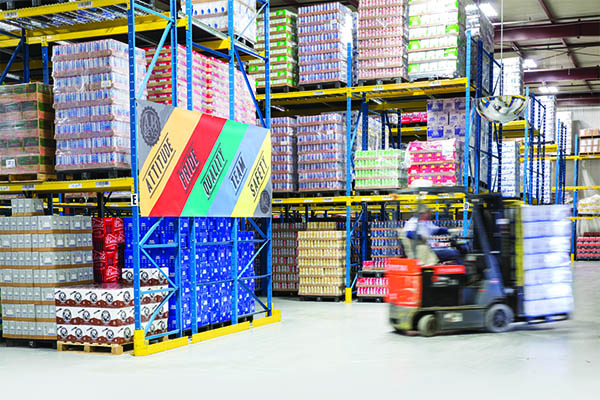Warehouse managers spend a lot of time on the inbound and outbound aspects of warehouse management, but studies show that the order picking process generally accounts for over half of warehouse operating costs[Ma1] . To help you save time, we’ve put together a list of 17 beverage warehouse picking best practices that will allow your warehouse workers to pick orders more efficiently. While we specialize in beverage warehouse picking, the same principles apply to almost any industry.
Why Using Warehouse Picking Best Practices Makes Sense
Warehouse picking requires intensive labor and expense, which is why pick operations are always on the list of improvements for distributors. When warehouse picking systems are optimized, it reduces costs and adds to customer satisfaction.
Generally, warehouse orders are filled by giving pick lists to an order selector. The selector then travels to areas where the items are housed, picking items as they find them, extracting them, and then matching them with the paperwork. When done without an inventory management system, human error can add more time, expense, and frustration to the process.
Of the steps in the warehouse order picking process, traveling accounts for 55% of the selector’s time. Clearly, if the selector has an understanding of where the products are, how many of them are sitting on the shelves, and how many they need, it would make picking and packing much easier.
And that’s where our warehouse picking best practices come in. Here are 17 tips to help you optimize your picking method.

Increase Efficiency With These Warehouse Picking Best Practices Tips
Not every supply chain distributor will utilize the same picking methods, and there are many processes, methods, and even tools to help optimize the process. Depending on your warehouse setup and design, you may currently use one of these picking systems:
- Individual order picking, picker-to-part, or piece picking is used by smaller distributors. With this method, the selector picks the entire order and adds them to a container or shipping pallet.
- Wave picking is for those distributors that pick and pack orders with multiple items and a varying number of SKUs. This method is conducted in waves, picking all zones at the same time.
- Batch picking happens when selectors pick for multiple orders in one trip. They pick like items or items that are located in similar areas on each trip.
- Zone picking is often used with batch picking and many distributors with large warehouses use this method. Selectors are assigned to a certain zone in the warehouse, and once they’ve picked all the orders, they pass them on to be packed.
No matter which picking method you use, chances are you can increase your efficiency and reduce operating costs with some changes to your system. Here are some of our favorite picking best practices tips:
- Create a zone that is stocked with all of your fast-moving products. This is called a fast-pick zone or an order-completion zone. It will allow your selectors to work faster and smarter—and reduce traveling and picking time if most of the orders can be filled from this zone.
- Where you put your fast-picking zone is important, too. Warehouses that locate this zone close to the shipping area save even more time than those that locate the area far away from it.
- Establish goals and a tracking system that helps reduce stock-outs and items that are not in their proper location. This will reduce traveling time for the selectors and increase productivity.
- Using warehouse management software to create batch orders for single-line orders will greatly increase productivity because it cuts down on travel time. A selector will be able to travel the same distance while picking multiple items for a batch of orders.
- Transition to hands free technology that allows your selectors to use their hands for picking, not scanning or looking up the next location. Today’s technology uses voice-directed or pick-to-light that will decrease pick time and save you money.
- Improve your inventory management, which helps selectors do their job more efficiently, by foregoing the annual physical inventory count and instead using cycle counting. With this system, you will routinely count small groups of inventory which will help you catch discrepancies, reduce leakage, and increase the accuracy of your inventory.
- Evaluate your inventory slotting regularly. While re-slotting the pick faces in your warehouse takes a lot of time, the benefits you get from doing it quarterly rather than yearly can save you time and money in the long run.
- Store SKUs separately. When you mix SKUs in the same bin it results in more floor time for the selector. That’s because the selector will be directed to a location, but because multiple SKUs are stored there, they will have to locate the product on the ticket. Studies have shown that this increases the pick time by 15 seconds per instance, which can add up during a day.
- If you are forced to pick vertically because of space limitations, be sure the store the fastest-moving items at ground level to increase the speed. Store the slower-moving items higher up because they aren’t picked as often.
- Set up hit density areas in the warehouse to increase productivity. For instance, if selectors pick from 50 areas, they will be much slower than if they only had 10 locations to pick from. You can categorize the zones according to their usage. Locate all of the high pick areas together to save even more time.
- Create a system where the items are only touched one time by the selectors. Once the item is picked, it should be loaded onto the shipping container having only been touched by the selector. This will reduce human error during the process.
- A simple way to speed up your picking times is to make sure that your shelves, bays, slots, and aisles are clearly marked with location signs.
- Use your warehouse management system to scan each item into its location. That way, the selector will always find the item right where it’s supposed to be.
- Wrong orders cost time and money, but you can reduce or eliminate them if you use barcode scanning when picking every item. To double down on this system, scan the items again at the dispatch point to ensure each item matches the shipping label. But, be sure the pallet SKU isn’t scanned in place of the product SKU at the dispatch area—otherwise, they won’t catch the mis-pick.
- Use a warehouse management system to prioritize your orders. When the last order is consistently picked first, it can cause delivery delays and unhappy customers.
- You need to understand the movements of your selectors to formulate a plan to increase productivity. And unless you use a warehouse management system to track their activities, you will have to guess who is productive and who isn’t.
- Finally, you can get your employees on the improvement bandwagon by posting the real-time progress of each selector. If you really want to stoke a competitive environment, post the errors and picking rates. And if you sense a lack of motivation among the selectors, offer a bonus each week or month to the person with the best stats. Your warehouse management system can easily generate those numbers for you.
Plan to Succeed When Establishing Beverage Warehouse Picking Best Practices
Before you implement any new best practices for your warehouse, it’s important to first establish some benchmarks. Only after you benchmark your current performance can you understand what goals you need to focus on.
And then after you know where you need to improve, you can use best practices to reach your new goals. And don’t forget the role of warehouse management software, one that seamlessly integrates with your sales and delivery solutions. A great WMS can help you efficiently operate you warehouse and manage your product flow.
Follow eoStar on LinkedIn!





